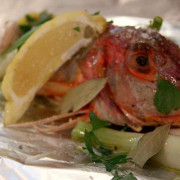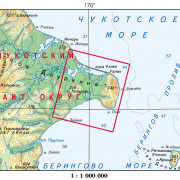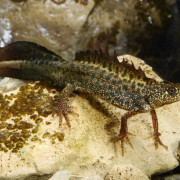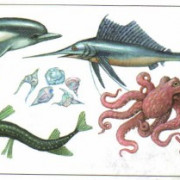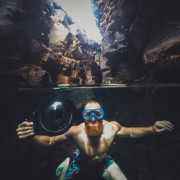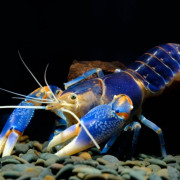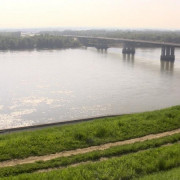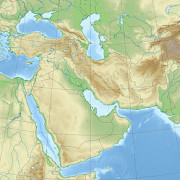belousov.KZ
Содержание:
History
The naming of the Sargasso Sea for its Sargassum seaweed dates from the early 15th-century Portuguese explorations of the Azores Islands and of the large «volta do mar» (the North Atlantic gyre), around and west of the archipelago, where the seaweed was often present. However, the sea may have been known to earlier mariners, as a poem by the late 4th-century author Rufus Festus Avienus describes a portion of the Atlantic as being covered with seaweed, citing a now-lost account by the 5th-century BC Carthaginian Himilco the Navigator.
In 1846, Edward Forbes hypothesized a post-Miocene land mass extending westward from Europe into the Atlantic:
| “ | If this land existed it did not extend to America (for the fossils of the Miocene of America are representative & not identical): where then was the edge or coastline of it, Atlantic-wards? Look at the form & constancy of the great fucus-bank & consider that it is a Sargassum bank. | ” |
| — Edward Forbes, from the Darwin Correspondence Project |
Depictions in popular culture
The Sargasso Sea is often portrayed in literature and the media as an area of mystery.
The Sargasso Sea features in classic fantasy stories by , such as his novel (1907), ‘s novel Don Sturdy in the Port of Lost Ships: Or, Adrift in the Sargasso Sea, and several related .’s describes the Sargasso Sea and gives an account of its formation.
The Sargasso Sea is frequently (but erroneously) depicted in fiction as a dangerous area where ships are mired in weed for centuries, unable to escape. The novel The Sargasso Ogre, published in 1933, takes place in the Sargasso where descendants of Elizabethan pirates still live. A similar story appears in (vol. 1) #3 (Spring 1942), «The Living Graveyard of the Sea,» which refers to it as a supposedly mythical place. Here the descendants of many different kinds of ships live in utopian harmony, until they are attacked by who wish to use it to their advantage. The premiere episode of , «Mystery of the Lizard Men», involves a spy ring operating in the Sargasso, underneath the (nonexistent) derelict ships. ‘ 1968 film (based on a 1938 novel, Uncharted Seas), depicts travelers lost in a Sargasso Sea infested with carnivorous seaweed, giant crustaceans, and descendants of Spanish conquistadores ruling over other trapped people, descendants of those mired in the weed centuries before. These depictions are parodied in season 1 episode «Ghosts of the Sargasso», set in the overlapping areas of the Sargasso Sea and the , which depicts supposed pirates whose ship was stuck in the sargassum for a decade and the ghost of the pilot of an experimental aircraft which crashed into the sea in 1969.
In ‘s The Shipwreck Island, is the catalyst for creating a society formed by survivors of countless ships trapped in the seaweed.
(1966) by is a rewriting of Charlotte Brontë’s from ‘s point of view.
Fred Andrew’s mystery novel, Plato’s Pond, features the fictitious land of Gaia, a continent in the middle of the Sargasso Sea.
The Sargasso Sea appears in two episodes of the 2016 television show .
The Sargasso Sea is referenced in the refrain of ‘s April 2016 song «Left Handed Kisses» (featuring singer ).»
Подборки
Армейские ПесниКлассика пианиноМузыка из рекламыДетские песни из мультфильмовМузыка для аэробикиСборник песен 70х годовДля любимого человекаКлассика в современной обработкеКлубные миксы русских исполнителей3D ЗвукДальнобойщикиЗарубежный рэп для машиныТоповые Клубные ТрекиМощные БасыДискотека 2000Песни про папуХристианские ПесниЗимняя МузыкаМузыка Для МедитацииРусские Хиты 90ХГрустная МузыкаRomantic SaxophoneТанцевальный хип-хопНовогодние песниЗарубежные хиты 80 — 90Песни про покемонаРомантическая МузыкаМотивация для тренировокМузыка для сексаМузыка в машинуДля силовых тренировокПремия «Grammy 2017»
Pollution
Owing to surface currents, the Sargasso accumulates a high concentration of non- waste.
The area contains the huge .
Several nations and nongovernmental organizations have united to protect the Sargasso Sea.
These organizations include the Sargasso Sea Commission
established 11 March 2014 by the governments of the Azores (Portugal), Bermuda (United Kingdom), Monaco, United Kingdom and the United States.
Bacteria that consume plastic have been found in the plastic-polluted waters of the Sargasso Sea; however, it is unknown whether these bacteria ultimately clean up poisons or simply spread them elsewhere in the marine microbial ecosystem. Plastic debris can absorb toxic chemicals from ocean pollution, potentially poisoning anything that eats it.
History
The naming of the Sargasso Sea for its seaweed dates from the early 15th-century explorations of the and of the large «» (the North Atlantic gyre), around and west of the archipelago, where the seaweed was often present. However, the sea may have been known to earlier , as a poem by the late 4th-century author describes a portion of the Atlantic as being covered with seaweed, citing a now-lost account by the 5th-century BC .
In 1846, hypothesized a post- land mass extending westward from Europe into the Atlantic:
If this land existed it did not extend to America (for the fossils of the Miocene of America are representative & not identical): where then was the edge or coastline of it, Atlantic-wards? Look at the form & constancy of the great -bank & consider that it is a Sargassum bank.
— Edward Forbes, from the Darwin Correspondence Project
Саргассум
Саргассум, или саргассовые водоросли – род бурых водорослей, объединяющий около 150 видов. Территория распространения охватывает моря тропических и субтропических широт. Редкие виды встречаются в морях северных областей. Так в дальневосточных морях России произрастают 7 видов саргассума.
Огромные, плавающие в воде скопления саргассовых водорослей наблюдаются в западной части Атлантического океана. Это обусловило соответствующее название широко известного Саргассового моря. Преобладающими двумя видами там являются саргассум погруженный и плавающий. Участки массового разрастания таких водорослей являются так называемыми «лугами океана», которые затрудняют передвижение морских судов.
Обычно водоросли данного рода растут в прибрежных районах морей и океанов, прикрепляясь ко дну. Но слоевища могут отрываться от субстрата и массово размножаться вегетативным путем, образуя громадные скопления, как в Саргассовом море.
Талломы водорослей выглядят как кусты, достигающие в длину, в среднем, двух метров (максимальные размеры – 10 м). Слоевища у большинства видов прикрепляются к подводным предметам посредством особой «подошвы», или ризоидов (корневой части). Ствол таллома и подошва сохраняются у растения на протяжении многих лет. Обычно ствол укороченный, в его верхних отделах из своеобразных пазух «листьев» развиваются длинные однолетние ветви. После разрушения ветвей, в их основании остаются короткие шипы.
Характерной особенностью саргассума является наличие одиночных воздушных пузырей на конечных ветках. Скопления этих пузырей напоминают гроздья мелкого винограда, поэтому первооткрыватели американского континента под предводительством Х.Колумба, увидев эти водоросли назвали их «сальгацо», что в переводе с португальского языка означает «виноград».
В структуре сердцевины молодых ветвей таллома различают тесные ряды плотно соединенных клеток, а в старых ветвях сердцевина распадается с формированием полости, внутри которой имеются рыхло переплетенные нити. Рост ветвей происходит при делении верхушечной клетки молодых побегов.
Размножение саргассума происходит бесполым (вегетативным) и половым путем. В оогониях содержится по одной яйцеклетке. По окончании периода созревания яйцеклетка оплодотворяется, образуется зигота, из которой развивается проросток. После формирования ризоидов проросток отделяется от материнского растения.
Значение саргассума. В хозяйстве человека эти водоросли используют для производства удобрений, кормовой муки, некоторых биологически активных добавок. В Юго-Восточной Азии отдельные виды употребляют в пищу.
Pollution
Owing to surface currents, the Sargasso accumulates a high concentration of non-biodegradable plastic waste.
The area contains the huge North Atlantic Garbage Patch.
Several nations and nongovernmental organizations have united to protect the Sargasso Sea.
These organizations include the Sargasso Sea Commission
established 11 March 2014 by the governments of the Azores (Portugal), Bermuda (United Kingdom), Monaco, United Kingdom and the United States.
Bacteria that consume plastic have been found in the plastic-polluted waters of the Sargasso Sea; however, it is unknown whether these bacteria ultimately clean up poisons or simply spread them elsewhere in the marine microbial ecosystem. Plastic debris can absorb toxic chemicals from ocean pollution, potentially poisoning anything that eats it.
Саундтреки
Из фильма В центре вниманияИз фильма Ван ХельсингИз сериала Дневники ВампираИз фильма Скауты против зомбииз фильмов ‘Миссия невыполнима’Из фильма Голодные игры: Сойка-пересмешница. Часть 2OST ‘Свет в океане’OST «Большой и добрый великан»из фильма ‘Новогодний корпоратив’из фильма ‘Список Шиндлера’ OST ‘Перевозчик’Из фильма Книга джунглейиз сериала ‘Метод’Из фильма ТелохранительИз сериала Изменыиз фильма Мистериум. Тьма в бутылкеиз фильма ‘Пассажиры’из фильма ТишинаИз сериала Кухня. 6 сезониз фильма ‘Расплата’ Из фильма Человек-муравейиз фильма ПриглашениеИз фильма Бегущий в лабиринте 2из фильма ‘Молот’из фильма ‘Инкарнация’Из фильма Савва. Сердце воинаИз сериала Легко ли быть молодымиз сериала ‘Ольга’Из сериала Хроники ШаннарыИз фильма Самый лучший деньИз фильма Соседи. На тропе войныМузыка из сериала «Остров»Из фильма ЙоганутыеИз фильма ПреступникИз сериала СверхестественноеИз сериала Сладкая жизньИз фильма Голограмма для короляИз фильма Первый мститель: ПротивостояниеИз фильма КостиИз фильма Любовь не по размеруOST ‘Глубоководный горизонт’Из фильма Перепискаиз фильма ‘Призрачная красота’Место встречи изменить нельзяOST «Гений»из фильма ‘Красотка’Из фильма Алиса в ЗазеркальеИз фильма 1+1 (Неприкасаемые)Из фильма До встречи с тобойиз фильма ‘Скрытые фигуры’из фильма Призывиз сериала ‘Мир Дикого Запада’из игр серии ‘Bioshock’ Музыка из аниме «Темный дворецкий»из фильма ‘Американская пастораль’Из фильма Тарзан. ЛегендаИз фильма Красавица и чудовище ‘Искусственный интеллект. Доступ неограничен»Люди в черном 3’из фильма ‘Планетариум’Из фильма ПрогулкаИз сериала ЧужестранкаИз сериала Элементарноиз сериала ‘Обратная сторона Луны’Из фильма ВаркрафтИз фильма Громче, чем бомбыиз мультфильма ‘Зверопой’Из фильма БруклинИз фильма Игра на понижениеИз фильма Зачарованнаяиз фильма РазрушениеOST «Полный расколбас»OST «Свободный штат Джонса»OST И гаснет светИз сериала СолдатыИз сериала Крыша мираИз фильма Неоновый демонИз фильма Москва никогда не спитИз фильма Джейн берет ружьеИз фильма Стражи галактикииз фильма ‘Sos, дед мороз или все сбудется’OST ‘Дом странных детей Мисс Перегрин’Из игры Contact WarsИз Фильма АмелиИз фильма Иллюзия обмана 2OST Ледниковый период 5: Столкновение неизбежноИз фильма Из тьмыИз фильма Колония Дигнидадиз фильма ‘Страна чудес’Музыка из сериала ‘Цвет черёмухи’Из фильма Образцовый самец 2из фильмов про Гарри Поттера Из фильма Дивергент, глава 3: За стеной из мультфильма ‘Монстр в Париже’из мультфильма ‘Аисты’Из фильма КоробкаИз фильма СомнияИз сериала Ходячие мертвецыИз фильма ВыборИз сериала Королек — птичка певчаяДень независимости 2: ВозрождениеИз сериала Великолепный векиз фильма ‘Полтора шпиона’из фильма Светская жизньИз сериала Острые козырьки
Ecology
Lines of sargassum in the Sargasso Sea
The Sargasso Sea is home to seaweed of the genus Sargassum, which floats en masse on the surface. The sargassum is not a threat to shipping, and historic incidents of sailing ships being trapped there are due to the often calm winds of the horse latitudes.
The Sargasso Sea plays a role in the migration of catadromous eel species such as the European eel, the American eel, and the American conger eel. The larvae of these species hatch within the sea and as they grow they travel to Europe or the East Coast of North America. Later in life, the matured eel migrates back to the Sargasso Sea to spawn and lay eggs. It is also believed that after hatching, young Loggerhead sea turtles use currents such as the Gulf Stream to travel to the Sargasso Sea, where they use the sargassum as cover from predators until they are mature.
In the early 2000s, the Sargasso Sea was sampled as part of the Global Ocean Sampling survey, to evaluate its diversity of microbial life through metagenomics. Contrary to previous theories, results indicated the area has a wide variety of prokaryotic life.
Sargasso Denizi Nerededir Sargasso Denizinin Gizemi ve zellikleri
Sargasso Denizi, Atlas Okyanusu’nun kuzey kesiminde (yukarıda yer alan haritada görüldüğü üzere Amerika’nın doğu sahillerine yakın bölge), 20°-35° kuzey enlemleri, 30°-70° batı boylamları arasında, “sargas” adı verilen kahverengi su yosunlarıyla kaplı alana verilen isimdir.
Okyanusun bu kesimindeki akıntıların oluşturduğu çember içinde kalan, yaklaşık 4 milyon kilometrekarelik bir alana yayılan bu yosunlar, bazen büyük kitleler, bazen öbek öbek biçiminde habitatlar oluşturmuşlardır.
Planaryalar, kabuklular, solucanlar, yosun hayvanları ile balık türleri, bu yosunlarla ortak yaşam sürerler. Sargossa Denizi’nin bir özelliği de, Akdeniz ve Batı Avrupa’nın çeşitli ırmaklarında yaşayan yılan balıklarının 2.5 yıl süren bir yolculuktan bu denize ulaşıp 300 metre derinlikte yumurtlamaları ve yaşam süreçlerini tamamlamalarıdır.

Sargossa Denizi’nin Kıyısı Yoktur – Eşsizdir Bir Doğası Vardır
Sargasso Denizi, doğanın garip ve eşsiz bir eseridir. Yaklaşık 700 mil genişliğinde, 2000 mil uzunluğunda ve Kuzey Atlantik’te yer alan denizin kıyıları yoktur. Her tarafta okyanus akıntıları ile sınırlıdır. Batısında Gulf Stream Akıntısı, doğuda Kanarya Akıntısı, kuzey tarafı Kuzey Atlantik Akıntısı ve güneyi ise Kuzey Atlantik Ekvator Akımı ile sınırlandırılmıştır. Bermuda adası batı kenarlarında yer almaktadır.
Her tarafında okyanus akıntılarının olmasına rağmen, bu deniz, soğuk Kuzey Atlantik’in aksine, istikrarlı hava koşulları ve sakin ve zayıf rüzgarlar ile garip bir şekilde sıcaktır. Dünyada hiçbir yerde görülmeyen bir başka garip fenomen ise, bu geniş su alanının yüzeyinde kalın bir tabaka oluşturan yoğun deniz yosunu ile kaplanmasıdır. Bu serbest yüzen altın-kahverengi deniz yosununun adı Sargassumdur ve bu nedenle denize adını verir.
Sargasso Denizi, çevresindeki akıntıları ile sakin kalmasına rağmen, burada subtropikal bir spiral oluşturulmuştur. Sonuç olarak, deniz yosunlarıyla kalanını tüm deniz alanını yavaşça saat yönünde döndürür. Dönme aynı zamanda çevre hava koşullarına da bağlıdır.
Sargossa Denizi Nasıl Keşfedildi?
Bazı Portekizli denizciler, ilk olarak 15. yüzyılın başlarında yosun yatağıyla Sargasso Denizi’ni keşfetti. 1492’de gezen Christopher Columbus bile, yoğun kahverengi yüzeyin engin genişliğine bakarken toprağa ulaşmış olması gerektiğini düşünüyordu.
Bugün bu deniz yosununun kıyıdan su akıntıları ile gelmediği kanıtlanmıştır. Aslında bu yosunlar bölgeye özgüler ve burada kıyıdan yüzlerce mil uzakta kuvvetli bir şekilde büyüyorlar. Ayrıca okyanus akıntıları nedeniyle, büyük miktarda deniz bitkisinin ve hatta çöpün yakındaki okyanus alanlarından Sargasso Denizi’ne sürüklendiği ve bu yabani otların içine gömüldüğü de bilinmektedir. Bunlar bölgeye taşındıktan sonra, her taraftaki akıntıların doğası gereği, dışarı çıkma ihtimalleri çok düşüktür.
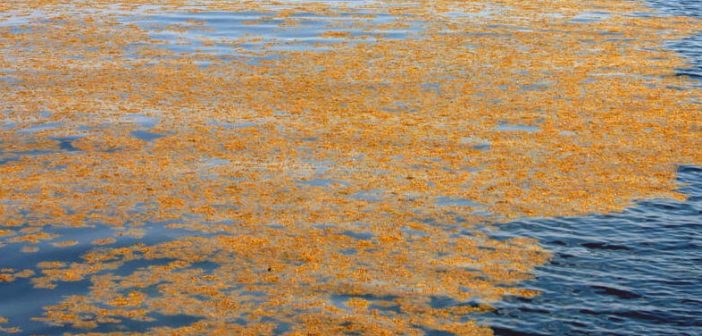
Sargasso Denizi’nin Korunması
Garip doğasının yanı sıra, uluslararası deniz bilimciler ve oşinografi uzmanları Sargasso Denizinin önemini ve daha geniş Kuzey Atlantik ekosistemindeki rolünü kabul ediyorlar. Bermuda Bilim Enstitüsü, bu alanı 50 yıldan fazla bir süredir araştırmaktadır.
Yoğun deniz yosunu tabakası balıklara, kaplumbağalara ve birçok deniz canlısına ev sahipliği yapıyor. Amerikan ve Avrupalı yılan balıkları buraya gelir ve yabani otları üreme alanı olarak kullanır. Genç Deniz Kaplumbağaları, okyanus akıntılarını seyahatlerinde kullanırken, yosun tabakasını da yırtıcı hayvanlardan gizlenmek amacıyla kullanıyorlar. Burada bulunan bitki materyalleri bu deniz alanından göç eden diğer balık türleri için zengin besinler olarak hizmet vermektedir. Göç eden kambur balinalar için bile harika bir yemlik yeri sunar.
Ne yazık ki, okyanus akıntıları bu alana birçok deniz bitkileri getirirken, aynı akıntılar biyolojik olarak parçalanamayan plastikler de dahil olmak üzere okyanusun diğer bölümlerinden büyük miktarda çöp getirmektedir. Bu, Bermuda Hükümeti tarafından Sargasso Denizini korumak ve korumak için başlatılan girişimin ana nedenidir.
Ecology
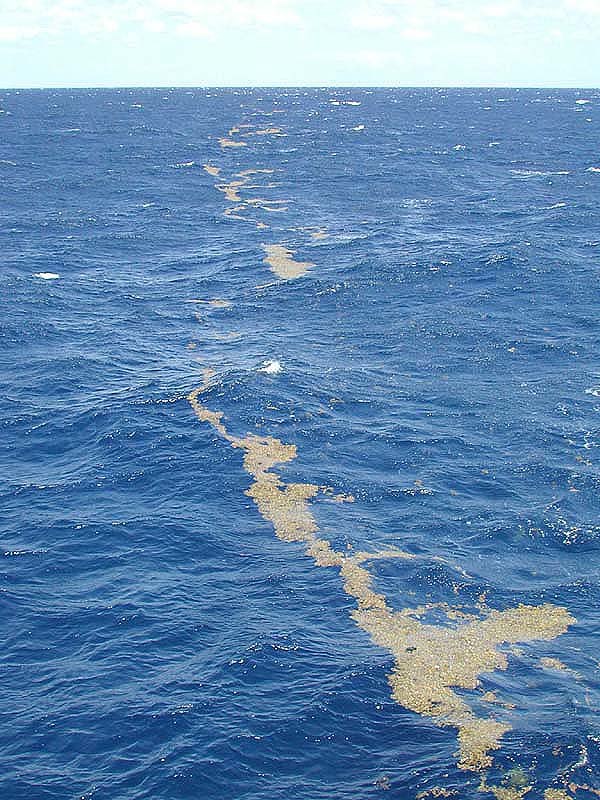
Lines of in the Sargasso Sea
The Sargasso Sea is home to of the genus , which floats en masse on the surface. The sargassum is not a threat to shipping, and historic incidents of sailing ships being trapped there are due to the often calm winds of the .
The Sargasso Sea plays a role in the of catadromous eel species such as the , the , and the . The of these species hatch within the sea and as they grow they travel to Europe or the East Coast of North America. Later in life, the matured eel migrates back to the Sargasso Sea to spawn and lay . It is also believed that after hatching, young use currents such as the to travel to the Sargasso Sea, where they use the sargassum as cover from predators until they are mature.
In the early 2000s, the Sargasso Sea was sampled as part of the survey, to evaluate its diversity of microbial life through . Contrary to previous theories, results indicated the area has a wide variety of life.
Depictions in popular culture
The Sargasso Sea is often portrayed in literature and the media as an area of mystery.
The Sargasso Sea features in classic fantasy stories by William Hope Hodgson, such as his novel The Boats of the »Glen Carrig» (1907), Victor Appleton’s Don Sturdy novel Don Sturdy in the Port of Lost Ships: Or, Adrift in the Sargasso Sea, and several related short stories.Jules Verne’s Twenty Thousand Leagues Under the Seas describes the Sargasso Sea and gives an account of its formation.
The Sargasso Sea is frequently (but erroneously) depicted in fiction as a dangerous area where ships are mired in weed for centuries, unable to escape. The Doc Savage novel The Sargasso Ogre, published in 1933, takes place in the Sargasso where descendants of Elizabethan pirates still live. A similar story appears in Green Lantern (vol. 1) #3 (Spring 1942), «The Living Graveyard of the Sea,» which refers to it as a supposedly mythical place. Here the descendants of many different kinds of ships live in utopian harmony, until they are attacked by Nazis who wish to use it to their advantage. The premiere episode of Jonny Quest, «Mystery of the Lizard Men», involves a spy ring operating in the Sargasso, underneath the (nonexistent) derelict ships. Hammer Film Productions’ 1968 film The Lost Continent (based on a 1938 Dennis Wheatley novel, Uncharted Seas), depicts travelers lost in a Sargasso Sea infested with carnivorous seaweed, giant crustaceans, and descendants of Spanish conquistadores ruling over other trapped people, descendants of those mired in the weed centuries before. These depictions are parodied in The Venture Bros. season 1 episode «Ghosts of the Sargasso», set in the overlapping areas of the Sargasso Sea and the Bermuda Triangle, which depicts supposed pirates whose ship was stuck in the sargassum for a decade and the ghost of the pilot of an experimental aircraft which crashed into the sea in 1969.
In Alexander Belyaev’s The Shipwreck Island, Sargassum is the catalyst for creating a society formed by survivors of countless ships trapped in the seaweed.
Wide Sargasso Sea (1966) by Jean Rhys is a rewriting of Charlotte Brontë’s Jane Eyre from Bertha Mason’s point of view.
Fred Andrew’s mystery novel, Plato’s Pond, features the fictitious land of Gaia, a continent in the middle of the Sargasso Sea.
The Sargasso Sea appears in two episodes of the 2016 television show Black Sails.
The Sargasso Sea is referenced in the refrain of Andrew Bird’s April 2016 song «Left Handed Kisses» (featuring singer Fiona Apple).»

